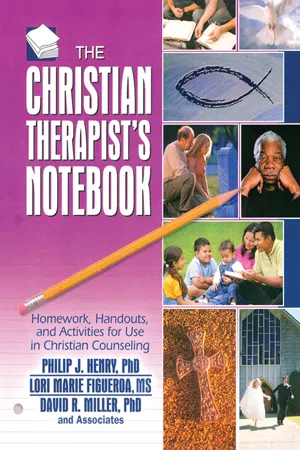
The Christian Therapist's Notebook
Homework, Handouts, and Activities for Use in Christian Counseling
- 346 pages
- English
- ePUB (mobile friendly)
- Available on iOS & Android
The Christian Therapist's Notebook
Homework, Handouts, and Activities for Use in Christian Counseling
About this book
Provide professionally sound and principled therapy based on the truth of God
Christians are faced with the same range of problems as everyone else. However, Christian therapists understand deeply the unique issues involved with their therapy. The Christian Therapist's Notebook is a single source for innovative, user-friendly techniques for connecting the everyday world of the client with Christian principles and Scripture. This creative, timesaving guide assists therapists in helping clients achieve therapy goals through professionally sound and principled exercises while always maintaining a positive, supportive connection with Christian beliefs. Helpful features include Scripture references relevant to common problems, case studies, vignettes, professional resource lists, client resource lists, in-session exercises, homework exercises, and handouts.
The Christian Therapist's Notebook bases its success on three foundations: the truth of scripture; the centrality of Christ; and the guidance of the Holy Spirit. The book's three sections include individuals, couples and families, and children and adolescents. Each chapter focuses on a single exercise to address an important issue that may be affecting the client. Chapters provide a guiding Scripture quote, an objective, rationale for use, clear and specific instructions, suggestions for a follow-up, a vignette illustrating the exercise's success, contraindications, extensive resources, and related Scriptures.
The Christian Therapist's Notebook exercises include:
- A New Creation, which uses a Christogram to personalize the Biblical promises and truths of the spiritual transformation
- Snapshots, which reveals repetitive behavior patterns in relationships
- Core Connections, which helps the client explore the organization of relational core connections to other people as well as to God
- Temptation Judo, which explores the connection between temptation and needs while uncovering God's promise of escape
- Broken Mirrors, which identifies unresolved issues affecting self-image and moves the client to a personal relationship with God
- The Book of My Life, which helps identify situations and people that have had an impact on clients, while helping them to acknowledge that God has a plan for them
- Tearing Down Strongholds, which helps take the client through the process of repentance
- It Was Wrong, which helps abuse victims deal with pain and frustration
- Bowing Down, which helps to restore a healthy relationship
- Panic Breaker, which helps get to the root of client fears
- Parenting after Divorce
- Self-esteem, which helps children with self-concept
- and many, many more!
The Christian Therapist's Notebook is the answer for practicing therapists, counselors, interns, pastors, educators, and students searching for activities for client therapy based upon the truth of God.
Frequently asked questions
- Essential is ideal for learners and professionals who enjoy exploring a wide range of subjects. Access the Essential Library with 800,000+ trusted titles and best-sellers across business, personal growth, and the humanities. Includes unlimited reading time and Standard Read Aloud voice.
- Complete: Perfect for advanced learners and researchers needing full, unrestricted access. Unlock 1.4M+ books across hundreds of subjects, including academic and specialized titles. The Complete Plan also includes advanced features like Premium Read Aloud and Research Assistant.
Please note we cannot support devices running on iOS 13 and Android 7 or earlier. Learn more about using the app.
Information
- It will guide the client in forming a philosophy of life or “worldview.” Like a compass, a correct worldview provides direction for navigation through the decisions of everyday life. Simply stated, a worldview is one’s practical philosophy of living. It influences how the client perceives the world and directs his or her choices. If the client understands who he or she is in Christ, and his or her true current spiritual reality, this will help develop a worldview that will aid the client in finding direction and purpose in life; it will also help him or her to negotiate the host of twists and turns life brings.
- This exercise is a growth-shaping catalyst for godly change. Knowing the changes God says are possible, to the believer, is a motivator for this kind of transformation and can sustain a life-changing faith. God’s kindness and love are what changes lives.
- If the client becomes well acquainted with the scriptures, he or she can recall these verses in times of trouble. When trials come in the walk of faith, and trials will come, knowing God’s Word can anchor the believer in the storm. The promises of God and the truth about His place in the life of the believer can be the difference between the sadness of a shipwrecked life and the joy of hanging ten on a big wave.
- This exercise can aid in building the client’s godly self-esteem and in elevating hope, by recognizing what God has already done for him or her. Encourage the client to take a second look at life and to see it as God sees it. We feel good about ourselves as Christians, not because of all the wonderful attributes we possess, but because God values us and has a wonderful plan for our lives.
Table of contents
- Cover
- Half Title
- Title Page
- Copyright
- Contents
- About the Authors
- Contributors
- Acknowledgments
- Introduction
- Section I: Homework, Handouts, and Activities for Individuals
- Section II: Homework, Handouts, and Activities for Couples and Families
- Section III: Homework, Handouts, and Activities for Children and Adolescents
- Index